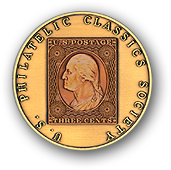
The History of the Ashbrook/Wagshal Reference Photo Collection
For almost 80 years the name Stanley Ashbrook has become synonymous with philatelic expertise. Mr. Ashbrook authored books on the 1 cent and 10 cent stamps of the 1855 Issue as well as numerous pamphlets and articles in the philatelic journals of his time. From the 1930s through the 1950s Stanley Ashbrook was considered by many to be the most knowledgeable postal historian in the United States. It is important to remember that Stanley Ashbrook was not a wealthy stamp dealer.
Mr. Ashbrook might best be known to serious collectors for his bi-weekly “Special Service” which ran for more than 6 years, beginning on June 1, 1951 and terminating on December 1, 1957. This newsletter contained photos and discussions of various philatelic items and topics. Even today, 55 years after the final issue, complete original runs are prized by philatelists. What isn’t well known is the answer to the question: “Where did these wonderful photos come from?” The answer was quite simple. Over the course of his professional career, Stanley Ashbrook took photographs of any item that was sent to him. Not just the ones seen in his Special Service but many thousands of pictures that were kept in his private reference collection.
Following his death in 1958, Stanley Ashbrook’s philatelic library was sold in H. R. Harmer’s #1211 Sale which was held on November 26th, 1958. The massive photographic reference collection was broken down and sold in lots 810-855. The majority of which were purchased by Philip Rust Sr. Over the next years Mr. Rust Sr. was able to acquire some of the lots that he had lost in the auction. In time, the vast majority of the reference collection was reassembled and stored at the Rust family estate in Georgia.
In the 1980’s Jerry Wagshal was on a mission. Mr. Wagshal had tried for many years to track down the location of the Ashbrook reference photo collection. Just reading through the Ashbrook auction catalog, any philatelist would wonder where it was and what could possibly exist within a database of thousands of photographs. Not knowing at the time that Mr. Rust was the purchaser, the only clue that Jerry had was that Mr. Rust had used Jack Molesworth as a dealer. Repeatedly told that there was no interest in selling the library, Jerry Wagshal waited patiently, inquiring every few years. Sometime following Mr. Rust Sr.’s passing, Jerry received the hoped for message, the collection might be available. Subsequently, the collection, as well as the entirety of Mr. Rust’s philatelic library was acquired from Philip Rust Jr.
The reference collection was returned to philatelic hands. Jerry Wagshal had always intended to publish the sum total of the Ashbrook reference collection. Unfortunately, illness prevented him from doing so. Upon his death, Mary Wagshal made plans for all of Jerry’s material: stamps, covers and research material to be made available to the collecting community.
Over the next 6 years thousands of scans were made of the reference collection.They are kept in the same system/non-system as that of Stanley Ashbrook. There are over 10,000 photographs with duplicates, triplicates and more of the same picture. Stanley Ashbrook often would take multiple prints using different filters and enlargement settings. The nomenclature used by Ashbrook was not based on any philatelic criteria. In fact most of the photos were assigned to different series due to photographic considerations. Series A (8 x 10” paper) and B (5 x 7” paper) were due to paper size and numbered by the order in which the items were received by him. The occasional annotation, with remarks such as “green” or “red (colored filters”) was a personal note for him to know whether a particular contrast was used in the picture. The result is a series of photographs with mixed issues, collateral materials, etc. appearing on the same photo plate. They are assembled just as they were received. Some photographs were sorted and put into binders. Others were already mounted in books. Still others came in loose packets. The electronic pictures are not sorted. Deal with it.

